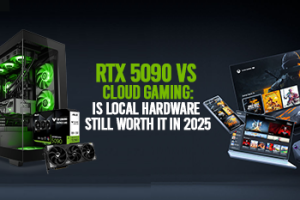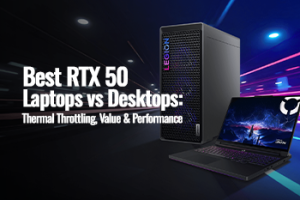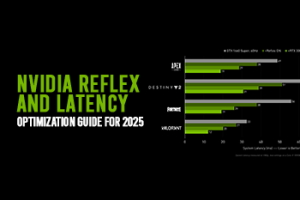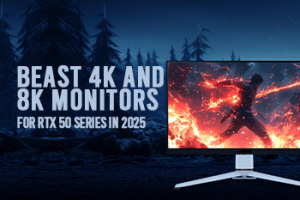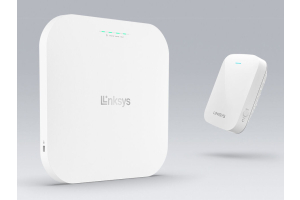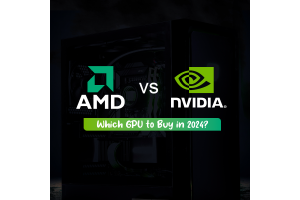RTX 5090 vs 5080 vs 5070 Ti: Choosing the Right Card for Your Needs
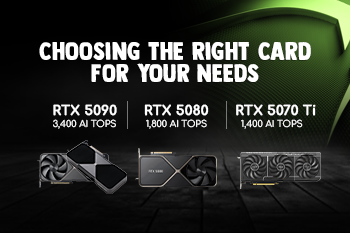

Over the years, the GeForce RTX 50 series has become extremely popular for its incredible and cutting-edge capabilities. Lower latency, improved graphics fidelity, significant AI power enhancement, DLSS4, and Multi-Frame Generation make graphics cards in this NVIDIA series a compelling choice for 3D artists, game developers, and filmmakers.
Though NVIDIA graphics cards have always been the leaders in computer graphics technology, the RTX 50 series has further pushed the boundaries, substantially improving the ray-tracing, CUDA core performance, and cooling mechanism. They have found applications in a wide range of applications.
In comparison with the earlier RTX 40 and RTX 30 series, these latest NVIDIA graphics cards have shown significant improvement. If you are interested in an in-depth description of NVIDIA GeForce RTX 5090, RTX 5080, and other graphics cards, we have in-depth technical articles available for each. You can read them here.
In this write-up, we are going to discuss a detailed comparison of RTX 5090, RTX 5080, and RTX 5070 Ti. This comparison will help you make an informed decision regarding which NVIDIA graphics card best serves your professional needs.
We first discuss the technical specifications of these GeForce graphics cards.
GeForce RTX 5090 vs RTX 5080 vs RTX 5070 Ti: Technical Specifications:
Here is a table summarizing the salient technical specs of these selected graphics cards of the GeForce RTX 50 series.
|
RTX 5090 |
RTX 5080 |
RTX 5070 Ti |
|
|
NVIDIA Architecture |
Blackwell |
Blackwell |
Blackwell |
|
DLSS 4 |
DLSS 4 |
DLSS 4 |
|
|
AI TOPS |
3352 |
1801 |
1406 |
|
Tensor Cores |
5TH Gen |
5th Gen |
5th Gen |
|
Ray Tracing Cores |
4th Gen |
4th Gen |
4th Gen |
|
3x 9th Gen |
2x 9th Gen |
2x 9th Gen |
|
|
NVIDIA Decoder (NVDEC) |
2x 6th Gen |
2x 6th Gen |
1x 6th Gen |
|
Memory Configuration |
32 GB GDDR7 |
16 GB GDDR7 |
16 GB GDDR7 |
|
Memory Bandwidth |
1792 GB/sec |
960 GB/sec |
896 GB/sec |
|
Ray Tracing Performance (TFLOPS) |
318 |
171 |
133 |
|
AI Performance (TOPS) |
3,352 |
1,808 |
1,406 |
|
CUDA Cores |
21,760 |
10,752 |
8,960 |
|
RT Cores |
170 4th Gen |
84 4th Gen |
70 4th Gen |
|
Minimum PSU |
1,000W |
850W |
750W |
Now, we compare these graphics cards in terms of various metrics such as performance in gaming, power efficiency, and performance in applications.
Performance:
GeForce RTX 5090 sits at the top of the NVIDIA RTX 50 family. Thanks to 92 billion transistors, it can deliver 3,352 trillion AI operations per second in computing performance. Furthermore, 21,760 CUDA cores (spread across 170 Streaming Multiprocessors) allow users to enjoy unparalleled performance that is next to impossible to find in the realm of graphics cards. GeForce 5090 can deliver up to 2x more performance than RTX 4090 and outperform other members of the RTX 50 family in many ways. In comparison with RTX 5070 Ti, it can deliver 2.4x higher maximum theoretical performance, making it suitable for high-end gaming and content creation tasks.
RTX 5080 and RTX 5070 Ti are both powered by Blackwell Architecture, and thus, they can deliver significantly enhanced performance in comparison with RTX 4080 and RTX 4070 Ti. RTX 5080 is a sweet spot, providing nearly as impressive performance as RTX 5090 but at considerably lower cost. You can enjoy a seamless performance of demanding applications and games even in ultra settings. GeForce RTX 5080 is thus suitable for strong 4K/1440p gaming and high-end content creation, including 3D rendering, and the like.
RTX 5070 Ti is an affordable option. It comes with a lower 8,960 Cuda Cores, enabling it to perform a comparatively lesser number of AI operations (1,406). When it comes to comparison with RTX 5090, it scores 75 against 93 in 3D modeling, video editing, and rendering apps, making it suitable for light creative tasks, 1440p/1080p gaming, and entry-level 4K (with DLSS 4).
4K Gaming Performance:
All these RTX Graphics cards are powered by 4th Gen Ray Tracing, allowing gamers to enjoy cinematic quality visuals at unprecedented speed. Furthermore, they all feature 5Th Gen tensor Cores, helping you enjoy an immersive gaming experience with accelerated neural rendering technologies. However, they do differ in 4K/8K gaming in many ways.
RTX 5090 Gaming Performance:
RTX 5090 has a 170 Ray-Tracing score, enabling this GeForce graphics card to deliver cutting-edge real-time ray tracing and global illumination in games. It also ensures improved ray-tracing triangle intersection performance, making it suitable for 4K/8K gaming at a higher refresh rate for smooth butterfly gaming performance and realistic lighting and shadows.
For instance, at 4K ultra settings, RTX 5090 can support 186 FPS for Forza Horizon 5, 125 FPS for The Witcher 3, 99 fps for Counter-Strike 2, 120 fps for Far Cry 6, 98 fps for Hogwarts Legacy, 185 fps for Call of Duty, 77 fps Cyberpunk 2077, and 129 fps for Tomb Raider.
RTX 5080 Gaming Performance:
Similarly, RTX 5080 also performs impressively at 4K ultra settings. For instance, it can support 135 FPS for Forza Horizon 5, 91 FPS for The Witcher 3, 87 FPS for Counter-Strike 2, 97 FPS for Far Cry 6, 69 FPS for Hogwarts Legacy, 136 FPS for Call of Duty, 62 FPS for Cyberpunk 2077, and 144 FPS for Tomb Raider.
GeForce RTX 5070 Ti Gaming Performance:
RTX 5070 Ti also gives a decent 4K performance. For instance, it can support 119 FPS for Forza Horizon 5, 83 FPS for The Witcher 3, 85 FPS for Counter-Strike 2, 89 FPS for Far Cry 6, 60 FPS for Hogwarts Legacy, 111 FPS for Call of Duty, 57 FPS for Cyberpunk 2077, and 107 FPS for Tomb Raider.
Creative Workload:
Multiple factors determine the performance of graphics cards when it comes to demanding creative workloads such as 3D rendering, 4K video editing, and the like. However, VRAM or video RAM, clock speed, memory bandwidth, cooling, and power efficiency are some factors that deserve our attention when choosing a specific GPU to meet professional needs.
It should be noted here that GeForce RTX 50 series GPUs support NVIDIA Studio. NVIDIA Reflex 2 represents the latest evolution of NVIDIA’s low-latency gaming technology, allowing gamers to enjoy faster responsiveness and a competitive edge. It has revolutionized the entire graphics pipeline, helping gamers experience faster target acquisition, quicker reaction times, and improved aim precision in competitive games.
NVIDIA Reflex 2 is set to feature Frame Warp technology that will further reduce the latency by decreasing the time between input and on-screen action of the player. Other salient highlights of NVIDIA Reflex 2 are dynamic boost and predictive rendering algorithm, allowing users to enjoy up to 75% lower latency, real-world impact, and competitive edge.
GeForce RTX 5090:

With 32 GB of ultra-fast GDDR7 memory on a 512-bit bus, GeForce RTX 5090 is a top-tier option for almost every demanding creative workload. In addition, GDDR7 memory technology can deliver up to 1,792 GB/s of memory bandwidth, making RTX 5090 suitable for high-resolution textures, big datasets, or training larger AI models. What’s more, the 3352 AI TOPS (trillions of operations per second in AI workloads) of RTX 5090 GeForce makes it the best video editing RTX 50 series and 3D rendering GPU in 2025. Therefore, experts rank GeForce RTX 5090 as the best GPU for large language models and one of the most suitable RTX 50 series GPUs for deep learning.
GeForce RTX 5080:

RTX 5080 is also a great choice when it comes to creative and demanding workloads. With 16 GB GDDR7 memory that can deliver up to 1801 AI TOPS operations, RTX 5080 features a great balance between performance and affordability. It is normally recommended for workloads such as 4K gaming, game development, 3D modeling and rendering, AI-assisted workflow, and high-resolution 4K or 6K video editing.
GeForce RTX 5070 Ti:

This is an affordable GPU that comes with a 16 GB GDDR7 memory configuration, and it can support up to 1406 AI TOPS. It is suitable for casual 3D rendering, animation, photo editing, graphic editing, streaming, and content creation. In conclusion, for demanding workloads, RTX 5090 and RTX 5080 are more suitable, and RTX 5070 is preferable for 1440p or 1080p high-refresh-rate gaming.
Thermal & Power Consumption:
Power consumption is another major metric that influences the ultimate choice regarding the best GPU for various professional needs. Enhanced power consumption is particularly concerning as it leads to increased operational costs as well as sometimes poor performance.
RTX 5090 is a power beast, featuring high-end and 32GB GDDR7, requiring robust cooling and a PSU. It is therefore equipped with a new dual-slot “Revolutionary Double Flow-Through” cooler design, enabling this graphics card to double the airflow, and stabilizing 72°C in a controlled environment (21–22°C ambient). Under demanding working conditions, RTX 5090 can draw up to 575 W. Overall, it leads both in thermal output and power consumption.
GeForce RTX 5080 is ranked between RTX 5090 and RTX 5070 Ti when it comes to thermal output and power consumption. It can draw up to 320W of power and can stabilize around 62°C. It is provided with a quiet fan, making it cooling effective and noise-free.
GeForce RTX 5070 Ti is a highly power-efficient graphics card, maintaining a gaming temperature level of around 63°C. It is provided with aided by triple axial-tech fans and advanced thermal pads, making it both efficient and quiet. Under demanding conditions, it can consume 300W of power, making it a perfect choice for energy-efficient 4K gaming. If you are looking for a GPU with effective thermal output and energy efficiency, RTX 5070 Ti should be your first choice.
Wrapping Up:
There is no denying that NVIDIA’s Force RTX 50 is the latest series of graphics cards that have taken the world of content creators and gamers by storm. Featuring powerful NVIDIA Blackwell Architecture, this series has proved to be a game-changer, allowing content creators and gamers to enjoy matchless performance, game-winning responsiveness, true-to-life graphics, ultimate gaming display technologies, and more. Of all the member of the RTX 50 series, RTX 5090, RTX 5080, and RTX 5070 Ti stand out for their cutting-edge capabilities.
After making this high-end graphics card comparison, we can conclude that the GeForce RTX 5080 is a sweet spot, combining both performance and affordability. You should go for RTX 5090 only when you need high-end AI capabilities for deep learning or other AI development tasks; otherwise, RTX 5080 can handle all of your graphics and computation needs without breaking the bank. Thanks for your read. We are looking forward to receiving your feedback to make our blogs more informative and engaging.









